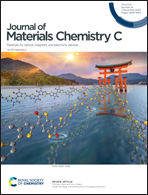Donor and acceptor interlock by a planar indolo[3,2,1-jk]carbazole for a suppressed non-radiative mechanism in thermally activated delayed fluorescent emitters†
Abstract
In this work, we report a novel molecular structure of the thermally activated delayed fluorescence (TADF) emitters with the donor–acceptor structure interlocked by a planar indolo[3,2,1-jk]carbazole (ICz) unit to suppress the non-radiative mechanism. Two isomeric molecules namely 2-(3-(4,6-diphenyl-1,3,5-triazin-2-yl)-2-(9′-phenyl-9H,9′H-[3,3′-bicarbazol]-9-yl)phenyl)indolo[3,2,1-jk]carbazole (TrzCbzICz-1) and 2-(5-(4,6-diphenyl-1,3,5-triazin-2-yl)-2-(9′-phenyl-9H,9′H-[3,3′-bicarbazol]-9-yl)phenyl)indolo[3,2,1-jk]carbazole (TrzCbzICz-2) were formed by altering the acceptor positions with respect to the donor while introducing the ICz unit positioned at ortho to the donor unit. The side by side substitution of ICz, donor, and acceptor in the TrzCbzICz-1 emitter resulted in a small singlet–triplet energy splitting, small non-radiative rate constant, and high up-conversion efficiency relative to the TrzCbzICz-2 emitter due to the interlocking of the donor and acceptor by a planar ICz unit. The TrzCbzICz-1 doped devices demonstrated a high external quantum efficiency of 20.3% with small efficiency roll-off and better performances than the TrzCbzICz-2 doped devices.
![Graphical abstract: Donor and acceptor interlock by a planar indolo[3,2,1-jk]carbazole for a suppressed non-radiative mechanism in thermally activated delayed fluorescent emitters](/en/Image/Get?imageInfo.ImageType=GA&imageInfo.ImageIdentifier.ManuscriptID=D0TC03534C&imageInfo.ImageIdentifier.Year=2020)


 Please wait while we load your content...
Please wait while we load your content...